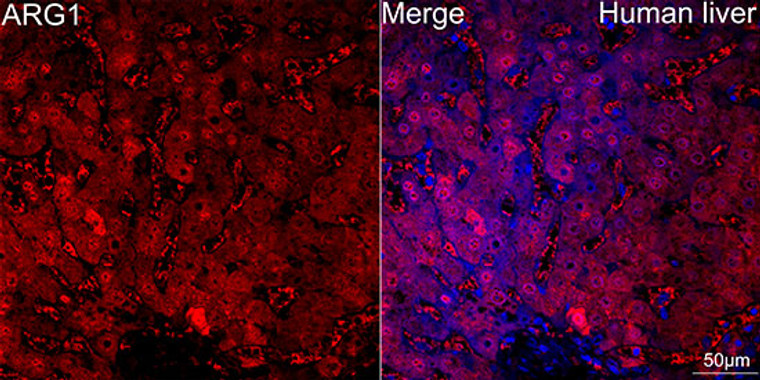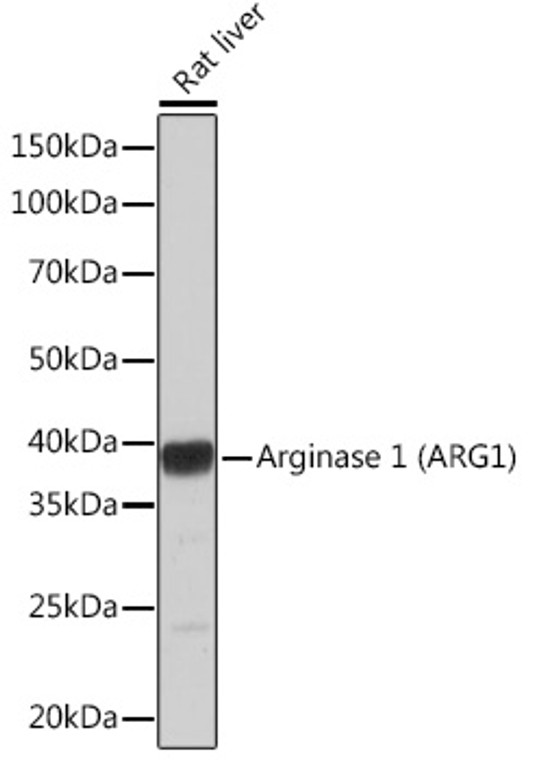| Host: |
Rabbit |
| Applications: |
WB/IF |
| Reactivity: |
Human/Mouse/Rat |
| Note: |
STRICTLY FOR FURTHER SCIENTIFIC RESEARCH USE ONLY (RUO). MUST NOT TO BE USED IN DIAGNOSTIC OR THERAPEUTIC APPLICATIONS. |
| Short Description: |
Rabbit monoclonal antibody anti-ARG1 (1-100) is suitable for use in Western Blot and Immunofluorescence research applications. |
| Clonality: |
Monoclonal |
| Clone ID: |
S8MR |
| Conjugation: |
Unconjugated |
| Isotype: |
IgG |
| Formulation: |
PBS with 0.02% Sodium Azide, 0.05% BSA, 50% Glycerol, pH7.3. |
| Purification: |
Affinity purification |
| Dilution Range: |
WB 1:2000-1:6000IF/ICC 1:50-1:200 |
| Storage Instruction: |
Store at-20°C for up to 1 year from the date of receipt, and avoid repeat freeze-thaw cycles. |
| Gene Symbol: |
ARG1 |
| Gene ID: |
383 |
| Uniprot ID: |
ARGI1_HUMAN |
| Immunogen Region: |
1-100 |
| Immunogen: |
A synthetic peptide corresponding to a sequence within amino acids 1-100 of human Arginase 1 (ARG1) (P05089). |
| Immunogen Sequence: |
MSAKSRTIGIIGAPFSKGQP RGGVEEGPTVLRKAGLLEKL KEQECDVKDYGDLPFADIPN DSPFQIVKNPRSVGKASEQL AGKVAEVKKNGRISLVLGGD |
| Tissue Specificity | Within the immune system initially reported to be selectively expressed in granulocytes (polymorphonuclear leukocytes PMNs). Also detected in macrophages mycobacterial granulomas. Expressed in group2 innate lymphoid cells (ILC2s) during lung disease. |
| Function | Key element of the urea cycle converting L-arginine to urea and L-ornithine, which is further metabolized into metabolites proline and polyamides that drive collagen synthesis and bioenergetic pathways critical for cell proliferation, respectively.the urea cycle takes place primarily in the liver and, to a lesser extent, in the kidneys. Functions in L-arginine homeostasis in nonhepatic tissues characterized by the competition between nitric oxide synthase (NOS) and arginase for the available intracellular substrate arginine. Arginine metabolism is a critical regulator of innate and adaptive immune responses. Involved in an antimicrobial effector pathway in polymorphonuclear granulocytes (PMN). Upon PMN cell death is liberated from the phagolysosome and depletes arginine in the microenvironment leading to suppressed T cell and natural killer (NK) cell proliferation and cytokine secretion. In group 2 innate lymphoid cells (ILC2s) promotes acute type 2 inflammation in the lung and is involved in optimal ILC2 proliferation but not survival. In humans, the immunological role in the monocytic/macrophage/dendritic cell (DC) lineage is unsure. |
| Protein Name | Arginase-1Liver-Type ArginaseType I Arginase |
| Database Links | Reactome: R-HSA-6798695Reactome: R-HSA-70635 |
| Cellular Localisation | CytoplasmCytoplasmic GranuleLocalized In Azurophil Granules Of Neutrophils |
| Alternative Antibody Names | Anti-Arginase-1 antibodyAnti-Liver-Type Arginase antibodyAnti-Type I Arginase antibodyAnti-ARG1 antibody |
Information sourced from Uniprot.org
12 months for antibodies. 6 months for ELISA Kits. Please see website T&Cs for further guidance










